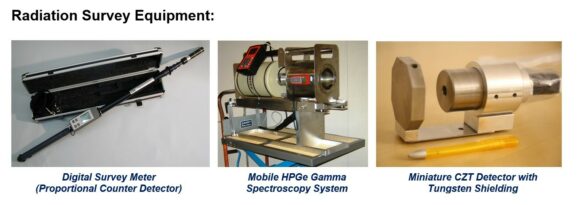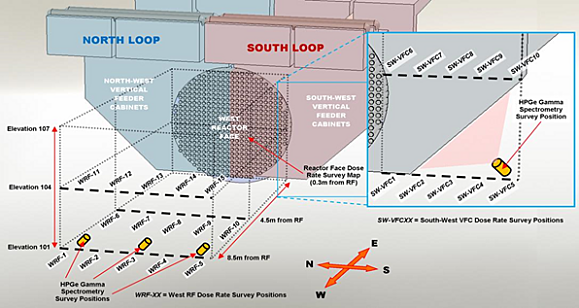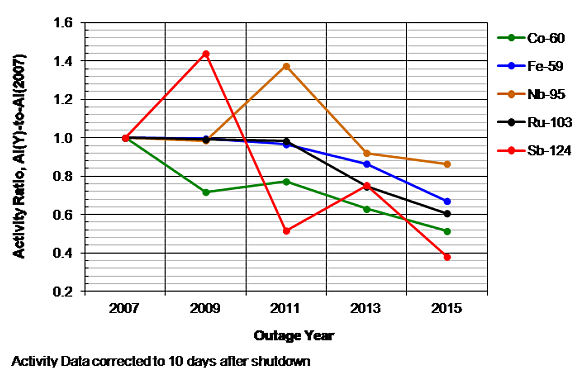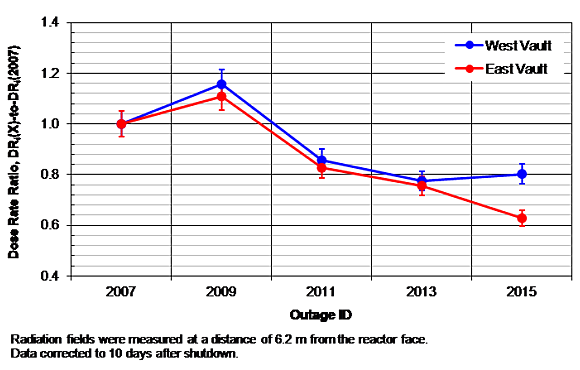Overview

As a key component of integrated Source Term Monitoring (iSTM), Outage Activity Transport Monitoring (OATM) entails the collection of data through in-situ gamma spectroscopy and dose rate measurements, followed by interpretation of data. This establishes the location, type (distributed or localized deposit), composition, and specific activity of radioisotopes within a reactor component or system.
Typically, OATM surveys focus on the Primary Heat Transport (PHT) system, including the reactor vault, reactor face, steam generators and heat exchangers, as well as the feeder cabinets.
We were responsible for summarizing the OATM process in a guideline for CANDU plants and developing a methodology for collecting and analyzing the radiation field and gamma spectral data in a consistent way. During reactor outages, we routinely perform gamma field characterizations of reactor components to determine the radionuclide distribution of deposits in the PHT system and to establish trends.
The OATM surveys give a spatial distribution of the radiation field in the reactor vault at various elevations and distances from the reactor face. The OATM data is also used for trending analysis and optimization of radiation protection.
Why Us?
-
Helping you Optimize Radiation Protection
We measure radiation during outages to create reactor face dose rate maps and gamma field distributions in the vault. Non-uniformities in the radiation fields are further analyzed to fully understand the activity deposition pathways.
-
Systematic OATM Survey Methodology
By establishing a methodology for systematically and consistently collecting and analyzing data we are able to trend and develop inter-comparisons of outage gamma fields and radionuclide activities.
-
Reliable Data
Gamma spectral data is used to estimate the absolute specific activity of individual radionuclides deposited on the primary heat transport system components using established and validated radiation models.
-
Specialized Equipment
Because we are regularly and frequently undertaking OATM projects we have built up a comprehensive set of reliable monitoring instruments that will provide consistent and reliable results.
-
Manage the Causes of Build-up
Knowing the pathways allows you to establish and manage the causes of radioactivity build-up and to optimize radiation protection.
-
Manage Personnel Doses
The OATM data provides you with the reliable data you need to effectively and safely manage performance and personnel doses.
Technical Abilities
Outage Activity Transport Monitoring (OATM) Survey Equipment
The specialized equipment we use in the OATM surveys includes:
- Digital gamma survey meters with internal proportional detectors and teleprobes
- Mobile gamma spectroscopy systems including high-purity germanium (HPGe) detectors
- Miniature gamma spectrometers based on cadmium-zinc-telluride (CZT) detectors
- Portable multichannel analyzers (digiDART,) for processing signals from the HPGe and CZT detectors

OATM Survey Locations
Several key reference points, reflecting activity deposition pathways in the primary heat transport system, are monitored. Numerous components are surveyed to collect detailed spatial information of the radiation field distribution and gamma spectral data for further interpretations. These components include:
- Reactor Face
- Reactor Vault
- Vertical Feeder Cabinet
- Horizontal Feeder Cabinet
- Steam Generator
- Moderator Heat Exchanger
- Bleed Cooler and Condenser
- Spent Primary Heat Transport System Purification Components (IX Resins and Filters)
The dose rate and gamma spectroscopy data from the surveys are then interpreted to estimate the absolute specific activity of individual radionuclides deposited on reactor components and the radionuclide contributions to the outage radiation fields.

OATM Data Analysis and Trending
Trend analyses are performed using outage radiation field and activity data compiled over more than ten years of OATM campaigns in a particular unit.
Measured radiation fields and reactor component radionuclide activities can exhibit various trends with time: increasing, decreasing or including both. Differences in these trends are rationalized by considering detailed operational data, such as reactor unit service history, primary coolant chemistry and radiochemistry parameters, primary heat transport purification system flow rates and service schedule, station condition records, etc. This information is compiled as a part of an integrated Source Term Monitoring (iSTM) program at CANDU stations and integrated with the OATM data.


Our Proven Experience
Quality Assurance & Technical Standards
- ISO 9001
- Quality Management System










